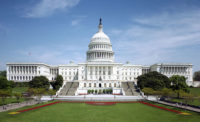On Feb. 10, the U.S. Department of Energy (DOE) issued a pre-publication Federal Register notice of proposed rulemaking (NOPR) for certain residential furnaces. The proposed rule would raise the national minimum energy-efficiency standard for residential nonweatherized gas furnaces from the current 78 percent AFUE — which is set to increase to 80 percent in November — to 92 percent while also setting new efficiency standards for electrical consumption in standby mode.
The proposed rule is a result of the highly publicized March 2014 joint settlement agreement between the DOE, American Public Gas Association (APGA), and interveners that, in part, vacated and remanded the DOE’s previous furnace rule, which had set regional furnace efficiency standards of 90 percent AFUE in the North while retaining an 80 percent minimum in the South and Southwest.
The DOE’s most recent proposed rule represents a significant increase in efficiency that would effectively eliminate noncondensing furnaces, and would significantly impact the design, installation, and cost of nonweatherized furnaces. The agency will begin taking comments once the notice is published, but, in the meantime, industry organizations have already indicated they are closely watching the rule and intend to provide input.
On High Alert
While many industry organizations have not yet taken an official position on the proposed rule, it is certainly on their radar. For some, including the Air-Conditioning, Heating, and Refrigeration Institute (AHRI), there are many questions the DOE needs to answer about the proposed rule.
“A little more than three years ago, the DOE agreed with AHRI, the environmental community, and other stakeholders that a new level of 90 percent AFUE in the North and the existing 80 percent AFUE in the South was appropriate and issued a direct final rule to that effect,” said Stephen Yurek, president and CEO, AHRI. “Now, even though natural gas and oil prices are lower than they were then — in the case of oil, much lower — the DOE now feels a 92 percent nationwide standard is appropriate. How can that be? What’s changed? These are questions the DOE should have to answer.”
Like AHRI, Heating, Air-conditioning, and Refrigeration Distributors International (HARDI) does not yet have an official position on the proposed rule. And, like AHRI, its leaders are keeping tabs on the situation.
“We’re currently looking over the economic analysis provided by the DOE and taking input from members and industry partners,” said Jon Melchi, vice president of government affairs and business development, HARDI. “Anecdotally, I can tell you I’ve heard concerns from members regarding the potential cost to homeowners who would require a significant retrofit and the cost benefit to those residing in warm weather climates.”
Charlie McCrudden, senior vice president of government relations for ACCA, said he was surprised by the DOE’s proposed 92 percent AFUE standard.
“It’s very aggressive,” he said. “It effectively eliminates noncondensing furnaces starting in 2021.”
McCrudden said ACCA plans to go through the technical support document (TSD), which was updated Feb. 25, to be sure the DOE has done its due diligence in ensuring the standard is both technically feasible and economically justified.
“This would harm a lot of people, including those in lower income brackets,” McCrudden said. “Right now, I know all stakeholders are reviewing the NOPR and the TSD, and I expect everybody to file lots of comments.”
The Timeline
At the time this issue went to print, the DOE had yet to publish the NOPR in the Federal Register. Once the proposed rule is published, there will be a 90-day comment period during which time interested parties can submit comments on the proposed rule.
“The DOE will then review the comments, make any changes, send the altered version to OMB [Office of Management and Budget] for review, and then publish it — whatever it is — as a final rule. This has to be done, per the settlement agreement, by April 2016,” McCrudden said. “Five years after that is the compliance date. So, let’s say it stays exactly the same as it is now, and let’s say the final rule is published on May 1, 2016, in the Federal Register. In that case, May 1, 2021, would be the date after which manufacturers could no longer manufacture equipment that is under 92 percent AFUE.”
Any noncompliant stockpiled inventory would be able to be installed after the implementation, and there would be a natural sell-through period.
Some Support
While the industry is skeptical of the new standard, environmental groups, including the Natural Resources Defense Council (NRDC), have come out in support of the DOE’s proposal. Robin Roy, director of building energy and clean energy strategy, NRDC, applauded the agency’s proposal in a recent press release.
“This new proposed efficiency standard will save U.S. consumers hundreds of millions of dollars in lower wintertime heating bills and will also reduce carbon pollution,” Roy said. “Natural gas furnace energy-efficiency standards have remained essentially unchanged since 1987, despite vast improvements in technology, but we think they can be even stronger than the DOE proposed. The NRDC will continue working with utilities, manufacturers, installers, and consumer groups to support the strongest possible cost-effective updated furnace efficiency standards.”
How to Get Involved
There is a public meeting scheduled for 9 a.m. to 4 p.m. March 27 at the DOE’s Forrestal Building, Room 8E-089, 1000 Independence Avenue, SW, Washington, DC 20585. The meeting will also be broadcast as a webinar; to register for the webinar, visit http://bit.ly/DOEmeeting.
The DOE is also asking for industry input on the standard, and anyone can comment. For more information about the proposed rule, and to submit comments, visit http://bit.ly/ResFurnaceRule.
Finally, for questions relating to the proposed furnace standard, email residential_furnaces_and_boilers@ee.doe.gov.
Publication date: 3/9/2015
Want more HVAC industry news and information? Join The NEWS on Facebook, Twitter, and LinkedIn today!









